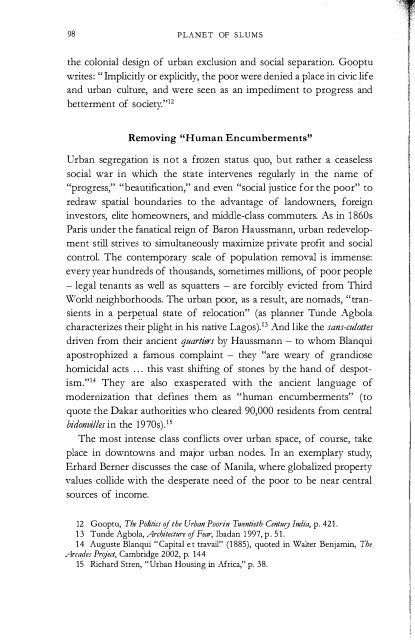Untitled - Rebel Studies Library
Untitled - Rebel Studies Library
Untitled - Rebel Studies Library
Create successful ePaper yourself
Turn your PDF publications into a flip-book with our unique Google optimized e-Paper software.
98 PLANET OF SLUMS<br />
the colonial design of urban exclusion and social separation. Gooptu<br />
writes: "Implicitly or explicitly, the poor were denied a place in civic life<br />
and urban culture, and were seen as an impediment to progress and<br />
betterment of society."12<br />
Removing "Human Encumberments"<br />
Urban segregation is not a frozen status quo, but rather a ceaseless<br />
social war in which the state intervenes regularly in the name of<br />
"progress," "beautification," and even "social justice for the poor" to<br />
redraw spatial boundaries to the advantage of landowners, foreign<br />
investors, elite homeowners, and middle-class commuters. As in 1860s<br />
Paris under the fanatical reign of Baron Haussmann, urban redevelopment<br />
still strives to simultaneously maximize private profit and social<br />
control. The contemporary scale of population removal is immense:<br />
every year hundreds of thousands, sometimes milJions, of poor people<br />
- legal tenants as well as squatters - are forcibly evicted from Third<br />
World neighborhoods. The urban poor, as a result, are nomads, "transients<br />
in a perpetual state of relocation" (as planner Tunde Agbola<br />
characterizes their plight in his native Lagos),u And like the sans-culottes<br />
driven from their ancient quartiers by Haussmann - to whom Blanqui<br />
apostrophized a famous complaint - they "are weary of grandiose<br />
homicidal acts ... this vast shifting of stones by the hand of despotism."14<br />
They are also exasperated with the ancient language of<br />
modernization that defines them as "human encumberments" (to<br />
quote the Dakar authorities who cleared 90,000 residents from central<br />
bidonvzlles in the 1970s).15<br />
The most intense class conf1icts over urban space, of course, take<br />
place in downtowns and major urban nodes. In an exemplary study,<br />
Erhard Berner discusses the case of .Manila, where globalized property<br />
values collide with the desperate need of the poor to be near central<br />
sources of income.<br />
12 Gooptu, The Politics f the Urban Poorin Twentieth- Century India, p. 421.<br />
13 Tunde Agbola, Architecture if Fear, Ibadan 1997, p. 51.<br />
. . .<br />
14 Auguste Blanqui "Capital et travail" (1885), quoted in Walter BenJamm, The<br />
Arcades Pro/eel, Cambridge 2002, p. 144<br />
15 Richard Stren, "Urban Housing in Mrica," p. 38.<br />
HAUSSMANN IN THE TROPICS<br />
Metro Manila [is] one of the most densely populated areas in the world.<br />
The price of one square meter anywhere near the commercial centers far<br />
exceeds the annual income of any jeepney driver or security guard. Yet,<br />
the very nature of the income-generating possibilities requires one to<br />
stay close to where the action is, because distance from place of work<br />
means prohibitive costs in time and money .... The logical result is wide<br />
spread squatting. Virtually all the gaps left open by city development are<br />
immediately filled with makeshift settlements that beat every record in<br />
population density.16<br />
Street vendors and other informal entrepreneurs also crowd Manila's<br />
central plazas, street corners, and parks. Berner describes the failure of<br />
market mechanisms or even private security to turn back this invasion<br />
of poor people who, after ail, are only behaving like rational economic<br />
actors - in the end, landowners are dependent upon state repression to<br />
keep squatters and vendors at bay, as well as to help evict residual populations<br />
of working-class renters and tenement-dwellers.<br />
Regardless of their political complexions and their different levels of<br />
tolerance for squatting and informal settlement on their peripheries,<br />
most Third World city governments are permanently locked in conflict<br />
with the poor in core areas. In some cities - Rio is a famous case - slum<br />
clearance has been going on for generations, but it gained irresistible<br />
momentum in the 1970s as land values exploded. Some metropolitan<br />
governments - Cairo, Mumbai, Delhi, and Mexico City, to name a few<br />
- built satellite cities to induce poor residents to relocate to the periphery,<br />
but in most cases the new towns simply sucked more population<br />
from the adjacent countryside (or, in the case of New Bombay, middleclass<br />
commuters) while the traditional urban poor clung desperately to<br />
neighborhoods closer to centrally located jobs and services. As a result,<br />
squatters and renters, sometimes even small landlords, are routinely<br />
evicted with little ceremony, compensation or right of appeal. In big<br />
Third World cities, the coercive Panoptican role of "Haussmann" is<br />
typically played by special-purpose development agencies; financed by<br />
offshore lenders like the World Bank and immune to local vetoes, their<br />
mandate is to clear, build, and defend islands of cyber-modernity<br />
amidst unmet urban needs and general underdevelopment.<br />
16 Berner, Dfending a Place, p. xv.<br />
99


